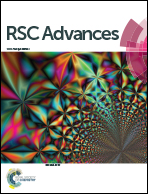Synthesis and spectral characterization of bimetallic metallomacrocyclic structures [MII2-μ2-bis-{(κ2S,S-S2CN(R)C6H4)2O}] (M = Ni/Zn/Cd): density functional theory and host–guest reactivity studies†
Abstract
A series of bimetallic dithiocarbamate metallomacrocyclic complexes [MII2-μ2-bis-{(κ2S,S-S2CN(R)C6H4)2O}]·L {R = benzyl; M = NiII 1, ZnII 2, CdII 3; R = 1-naphthylmethyl; M = NiII 4, ZnII 5, CdII 6 and L = Et3N for 1, 4 only} were efficiently synthesized through a self-assembly process involving 4,4′-bis(arylmethylamino)diphenyl ethers L1, L2, CS2 and M(OAc)2. The compounds were characterized by micro-, relevant spectroscopic (ESI-MS, FT-IR, 1H, 13C and 1H DOSY NMR, UV-visible absorption, fluorescence) and TGA/DTA analyses. The geometry of all the complexes has been optimized by a DFT method with B3LYP/LanL2DZ basis sets. Notably, the fluorescence properties of L1 and L2 were enhanced upon complexation with Ni, Zn or Cd metal ions in the binuclear complexes 1–6. NiII complexes 1 and 4 gave stable residual masses of 20.1% and 29.5% in their thermogravimetric analyses which correspond to NiS (calc. 14.18% for 1 and 12.26% for 4) plus char, respectively. A Job plot experiment reveals the ability of macrocycles 1–4 to form host–guest complexes in 1 : 1, 1 : 2 and 2 : 1 stoichiometry, depending on the relative sizes of the hosts and guests and their electronic nature.
![Graphical abstract: Synthesis and spectral characterization of bimetallic metallomacrocyclic structures [MII2-μ2-bis-{(κ2S,S-S2CN(R)C6H4)2O}] (M = Ni/Zn/Cd): density functional theory and host–guest reactivity studies](/en/Image/Get?imageInfo.ImageType=GA&imageInfo.ImageIdentifier.ManuscriptID=C5RA22175G&imageInfo.ImageIdentifier.Year=2015)

 Please wait while we load your content...
Please wait while we load your content...